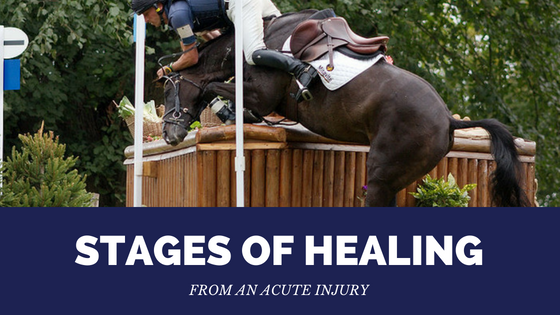
The 4 Stages Of Healing Following An Acute Injury
When horses (and other athletes) sustain an acute injury, healing follows a standard process. Read on to find out more.
The Four Stages
Haemostasis
Occurs directly following an acute injury, whereby platelets in the blood adhere to the injured site. Within this phase, platelet activation creates an amorphous shape change, more suitable for clotting whilst simultaneously releasing chemical signals to promote clotting.
Inflammation
Occurs briefly after the haemostasis phase. This phase thus ensures that damaged/dead cells, bacteria, pathogens and debris are removed via phagocytosis. Platelet-derived growth factors are released into the wound, causing the migration and division of cells during the proliferative phase.
Physiotherapists can influence this phase to reduce excessive inflammatory responses and pain via the application of cryotherapy, compression, kinesio taping and passive range of motion.
Proliferation
In this sub-acute phase, angiogenesis, collagen deposition, granulation tissue formation, epithelialisation, and wound contraction occur. In angiogenesis, vascular endothelial cells form new blood vessels. Fibroplasia and granulation tissue formation occurs after fibroblasts grow and form a new, provisional extracellular matrix by excreting collagen and fibronectin.
Concurrently, re-epithelialisation of the epidermis occurs; epithelial cells proliferate providing cover for the new tissue followed by myofibroblasts decreasing the size of the wound via contraction.
Physiotherapists can influence this phase of healing via the implementation of both ice and heat as a contract agent to help improve wound closure, circulation and tissue organisation.
Maturation (remodelling)
Within this sub-acute – chronic phase, collagen is realigned along tension lines and cells that are no longer needed are removed. Physiotherapy can influence this stage through implementing heat/thermal based treatments, more vigorous massage/manual therapy techniques, strength training and movement to align fibres in the direction of motion/pull.
This is shown in more detail in this SlideShare
Optimal Wound Healing
Optimal wound healing follows a sequential cascade of overlapping processes as discussed above. This process requires the coordinated completion of a variety of cellular activities including phagocytosis, chemotaxis, mitogenesis, collagen synthesis and synthesis of other matrix components.
Infection or prolonged inflammation/irritation can lead to chronic non-healing wounds, joint effusion/distension, oedematous regions, reduced range of motion and muscular output whereby the normal healing process is disrupted and ‘stuck’ within the inflammatory or proliferative phases due to incomplete microbial clearance.
Thus, leading to elevation of pro-inflammatory cytokines, increased levels of matrix metalloproteases and decreased levels of protease inhibitors occurring.
As such, understanding when to apply cold using solutions like Equi-Ice and hot therapy can significantly impact upon the healing process and even aid with a return to work of your horse in a more timely manner.
